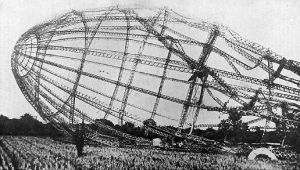
The Church is at the end of a long narrow road leading from the
B1026. The road also leads to the Copt Hall National Trust Site,
which is part of a conservation jigsaw to link together over 25 km
of the Essex coast from Tollesbury Wick in the south to Fingringhoe
Wick in the North. This small late 15th century church, standing by
Copt Hall, consists of a chancel, nave and West Tower. It was much
restored in 1888 following the severe earthquake damage of 1884,
the upper part of the Tower being rebuilt in 1886. The one bell
dates from 1820 and the oak screen from 1895. Little Wigborough was
virtually an unheard of village until one night in 1916.

In 1915 German Zeppelins commenced bombing missions over the UK.
On the night of 23rd/24th, September 1916, Zeppelins set out to
bomb London. These newly designed and built Zeppelins were superior
to the Zeppelins which had previously flown over England. The L32
was shot down and crashed in flames in Great Burstead. The Zeppelin
L33 was hit by anti-aircraft from the London defences, its gas
balloon was ruptured, and the crew tried to flee for home across
the North Sea. However, they did not have enough fuel to make the
journey and turned back over the Blackwater looking for a place to
land.
They chose some fields at Little Wigborough, where the airship
eventually touched down in a ‘text book’ landing, straddling the
road from the village to the church. The crew got out and set fire
to the airship before knocking on the door of a nearby cottage to
ask the way to Colchester. The occupants were too scared to open
the door and the Germans set off towards the village. Special
Constable Edgar Nicholas, who lived nearby, made his way to the
scene and came across the crew walking along a road, they were
taken into custody and transferred by soldiers to the village hall
at West Mersea for the night. The prisoners were later taken to
Colchester barracks.
The Wigborough Zeppelin attracted a large crowd – even at 4am,
not three hours after the airship had landed, the roads around the
village were blocked with horse and carts, bicycles, pedestrians
and army vehicles as people came from all over the place to see
what was going on. Some even arrived by aeroplane!
Despite being fired, enough of the Wigborough airship survived
for spectators to see its bulk for themselves. The airship was the
subject of great attention by spectators but the guarding of it was
expeditiously arranged by the military as parts of the airship were
still relatively undamaged, she was later studied in great detail
and many aspects of her design were incorporated into later British
airship designs. Numerous items ejected from the airship during the
crew’s vain attempt to maintain height were found in surrounding
countryside, including guns, maps, bits of machinery and even food,
some souvenirs were gathered up and even today parts of L32 and L33
can be found for sale on ebay and collectors’ forums.
Take a view minutes to look inside the church where part of
Zeppelin can still be seen – along with several newspaper cuttings
about the event in Little Wigborough Church and the church’s
history and a special memorial plaque at the back of the church to
Zeppelina.
The co-ordinates get you to St Nicholas Church (there is
parking nearby). There is public access to the churchyard but due
to nearby private property can we suggest that you only visit
during reasonable daylight hours. In the graveyard you will need to
find two graves to solve the clues which will give you the
coordinates for the final cache which is a small black pot, a short
distance away, containing log book and pencil.
You need to find
1. The grave of Alexander Bean and Eliza Henrietta Bean
There is a quote from St Matthew Chapter X8
There is a quote from Hebrews take away the number of the verse
from the number of the chapter = Y
Henrietta died on Z6th March
2. The Grave of Alfred John Wright
Died on November 1? (?x2 +1=R)
The number of letters in Alfred’s Dad’s name take away the
number of letters in Alfred’s mum’s name = S
Died Age T5
N 51.47.RST
E 000.52.XYZ